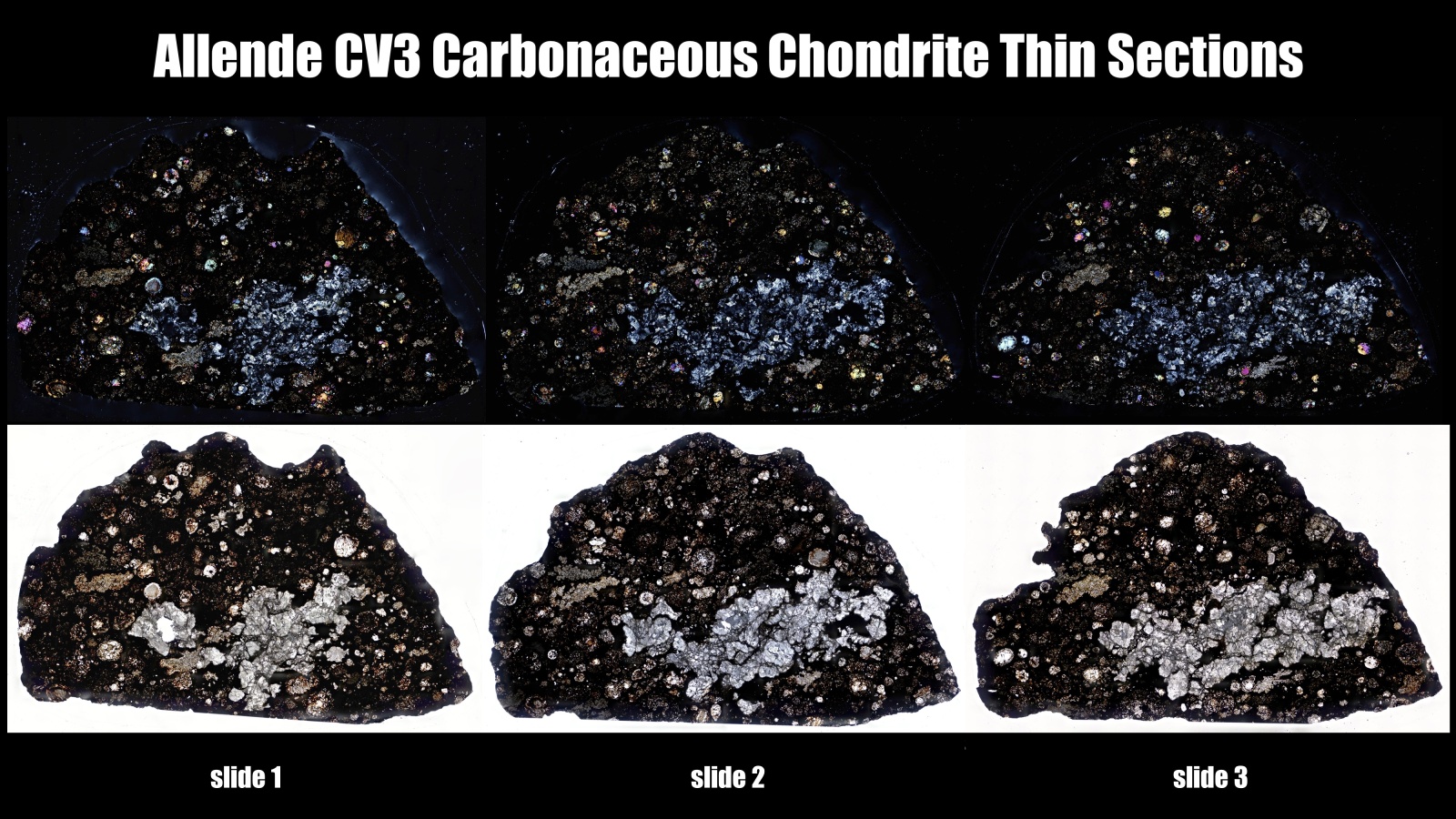|
Roll Overs:
#1
#2
#3
#4
#5
#6
#7
#8
#9
|

|
|
Copyright (c) Steve Brittenham.
|
What is a thin section? What do all the colors mean?
|
CV3
TKW 2 tons. Observed fall 8 February 1969, at the village of Pueblito de Allende, Chihuahua, Mexico.
    Smithsonian Smithsonian
Steve writes:
The February 1969 Allende meteorite is a famous and scientifically important carbonaceous chondrite that most of Paulís readers are quite familiar with. Itís also been the subject of many prior MPOD posts, including two previous ones from me (8/22/17 and 8/26/17). Allende has provided significant contributions to meteoritics Ė as well as having the honor of being the first extra-terrestrial material to pass through NASAís Lunar Receiving Lab as a test prior to the moon rocks returned by the Apollo missions Ė but I wonít elaborate here as there is a lot of online information that Paulís readers can easily find if interested.
My prior posts featured individual stones, end cuts, and slices. In todayís post, I thought it might be fun to show three thin sections taken from the same Allende plug (grouped in Photo 1 and shown in greater detail in Photo 2ís animated GIF comparison with each slideís xpol image on top and its corresponding white light image on the bottom). This particular plug had a pronounced CAI that can be seen through the series of slices. Their full gigapixel resolution xpol and white light mosaics, respectively, can be seen on Gigapan:
Slide 1, xpol
Slide 1, white light
Slide 2, xpol
Slide 2, white light
Slide 3, xpol
Slide 3, white light
For those new to Gigapan, click the diagonal arrows at the upper right of the image to go full screen, then use your mouse to pan around and your mouse wheel to zoom in and out.
Itís not clear whether these slides are adjacent thin sections, or whether others were created in between them Ė while there are some similarities between pairs of slides, even the larger chondrules donít show any remnants in any others, so I suspect that either these are not adjacent, or there was a lot of material lost between slices.
Since individual xpol images by themselves are more artistic than scientifically useful, I thought Iíd bridge the gap by providing some animated GIFs of a few more interesting areas (I assume this is somewhat like a post John Kashuba did over four years ago, though the link to his image is broken so I canít say for sure). But because my stage is motorized for mosaicking, rotation is not possible; instead, while not the way petrology specimens are traditionally viewed, I simply rotated the source polarizer from extinction through seven subsequent steps of 22.5 degrees, with a final image minus the source polarizer to show what each area looks like in white light (that image persists longer so the viewer can tell when the cycle repeats). A more correct approach would have been to simultaneously rotate both the source and analyzer polarizers the same amounts, but the analyzer on my Ultraphot has a multi-turn knob that would have made this fairly tedious, and since these GIFs werenít meant for any actual scientific analyses, I got lazy and only rotated the source polarizer.
The animated GIFs in Photos 3 through 6 show individual chondrules; Photo 7 shows a cluster of chondrules; Photo 8 shows a mixture of chondrules and CAI material; while Photo 9 focuses specifically on CAI material. |
|
|
| |
E.T.
10/1/2022 2:49:34 PM |
Hey Steve, cool beans! Thanks for sharing.
|
Steve Brittenham
10/1/2022 9:35:44 AM |
Thanks Alexander. Paul had to downsize the GIFs because they were quite large (one was 18 MB!), but if you want better resolution and detail, you can jump to the Gigapan links and explore lots of features. And Paul, congratulations on your 11th anniversary of MPOD! |
Alexander Natale
10/1/2022 5:37:05 AM |
Great post, really enjoyed viewing the time-lapse videos. Thank You. |
| |
|